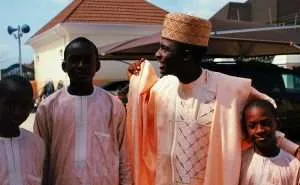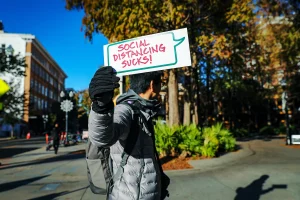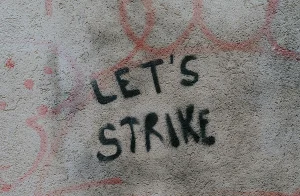What is Institutionalized Discrimination?
Institutionalized discrimination is when discriminatory practices are embedded in the structure of an organization. In this article, I argue that institutionalized discrimination is embedded into sociology departments.

Does Institutionalized Discrimination exist in Sociology Departments?
One of my reflections upon being a graduate student at Purdue was a continuous feeling of workplace discomfort. Sure, there is the social awkwardness of a bunch of really smart people crammed in a relatively small work environment that might be reminiscent of a reality-social-experiment, but that is not the discomfort that I speak of here. Frankly, anyone who has worked in academia for a period of time may laugh at “academic-awkwardness,” but assuredly we have all found ourselves fitting the stereotype.
To see the real problem with the academic work environment, we have to consider these small-scale discomforts in association with the intense power dynamics in academia. Whether a person is a graduate student, instructor, or junior faculty, we are constantly having to publicly manage “up” and “down” relationships. In other words, we are expected to simultaneously manage interactions where we are the teacher, with interactions in which we are a learner.
This in itself may not be “bad” but what has happened within the institution of academia is a culture where “teacher=dominant” and “learner=submissive.” This cultural norm in sociology departments can lead to an environment where the people who have the power to create the standard of “acceptable awkward” tend to be of an older generation skewed white and male.
Examples of Institutionalized Discrimination
I have seen countless examples of this process play out over three years in the sociology department at Purdue. I have seen a graduate coordinator introduce two new graduate students as a married couple when they were not. I have seen a senior faculty member refer to a junior faculty member as Ms., rather than Dr. I have even witnessed a professor inadvertently suggest to a black student from Philadelphia that she may particularly enjoy DuBois’ Philadelphia Negro.
These are all awkward gaffes the same as if I had tried to push open a door meant to be pulled, or if I accidentally said good morning instead of good afternoon. The problem is a small portion of the work environment gets to select the appropriate level of “accidental” or “awkward” and leaves so many people wondering if bringing attention to micro-agressions may impact their grade or evaluation. This power dynamic along with weak institutional sanctions for misbehavior leaves an environment where racism and sexism can exist in a sociology department despite knowledge of race and gender produced in the field of sociology.
Concluding Thoughts
Back to my point about the discomfort I felt in the work environment at Purdue. It is not that I, as a white man, ever specifically faced discrimination. My point is that with the current sociological understandings of race and gender, sociologists should all feel uncomfortable in such an environment. It places fear and resentment at the center of an environment that should be about collaboration and critique of old ideas. My point is that an organization is not designed to adequately train new sociologists unless it has managed to implement the proper knowledge related to racial and gender diversity.
This is not intended to be a direct critique of Purdue, as I am certain this is a problem across many sociology departments, but this is a critique of how sociology is currently organized. As a discipline, sociology is organized in such a way that rewards the production of knowledge over application.
This has left us in a position where we know more about diversity and inclusion than has been implemented in the organizational structures of universities and departments. Sociology departments should be the bastion of inclusive and collaborative work environments. It could be as simple as incorporating elements of community-based research, applied research labs, or other tenants of application into departments.
Frequently Asked Questions about Institutionalized Discrimination
What is institutionalized discrimination?
Institutionalized discrimination refers to the systematic and structural practices within organizations, institutions, or societies that intentionally or unintentionally favor certain groups over others, resulting in unequal treatment and opportunities.
How does structural discrimination differ from individual discrimination?
Individual discrimination involves actions or attitudes by individuals that result in unequal treatment based on factors like race, gender, or ethnicity. Institutionalized discrimination, on the other hand, is embedded in the policies, practices, and structures of larger systems.
What are examples of institutionalized discrimination?
Examples include discriminatory hiring practices, unequal access to education, biased criminal justice systems, and policies that disproportionately affect certain racial or ethnic groups. It can also manifest in housing, healthcare, and financial systems.
How does institutional discrimination perpetuate social inequality?
Institutionalized discrimination creates and perpetuates social inequality by systematically favoring certain groups, limiting opportunities for others, and reinforcing existing power dynamics. This can result in long-term disparities in areas such as income, education, and healthcare.
Can institutionalized discrimination be unintentional?
Yes, institutionalized discrimination can be unintentional and arise from policies or practices that, while not explicitly discriminatory, have a disparate impact on certain groups. Unintentional discrimination is often referred to as systemic or structural discrimination.
What are the effects of institutionalized discrimination on marginalized groups?
The effects can include reduced access to opportunities, limited social mobility, heightened vulnerability to poverty, and increased exposure to negative stereotypes. Institutionalized discrimination can also contribute to feelings of marginalization and injustice.
How can societies address and combat institutionalized discrimination?
Addressing institutionalized discrimination requires a comprehensive approach, including policy changes, legal reforms, awareness campaigns, diversity and inclusion initiatives, and ongoing efforts to challenge and dismantle discriminatory structures.
What role does allyship play in combating institutionalized discrimination?
Allyship is crucial in combating institutionalized discrimination as individuals and groups work together to raise awareness, advocate for change, and support policies and initiatives that promote equality and dismantle discriminatory systems.







